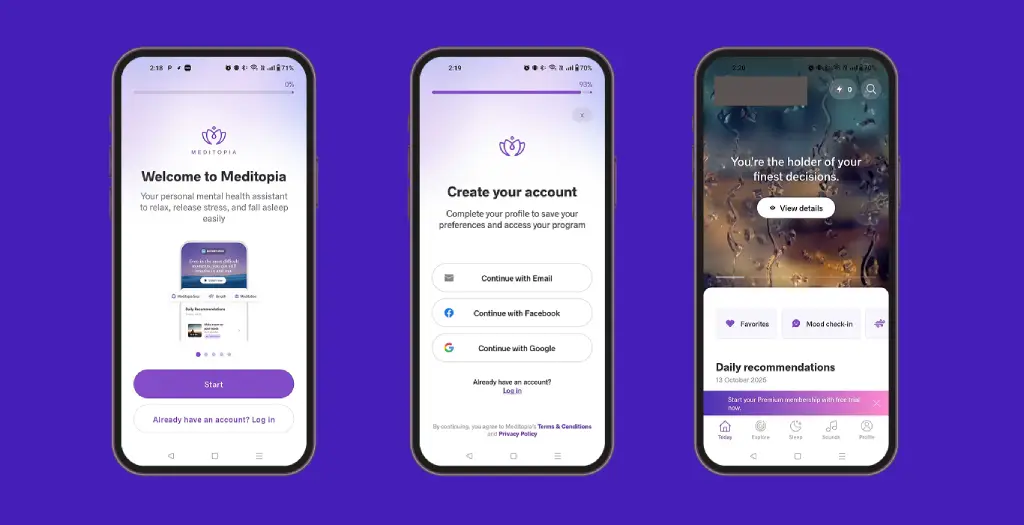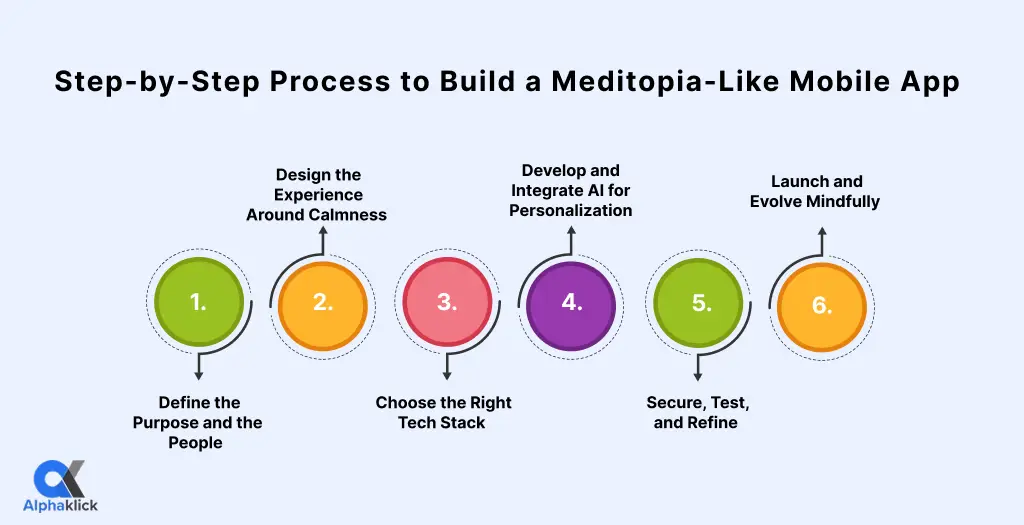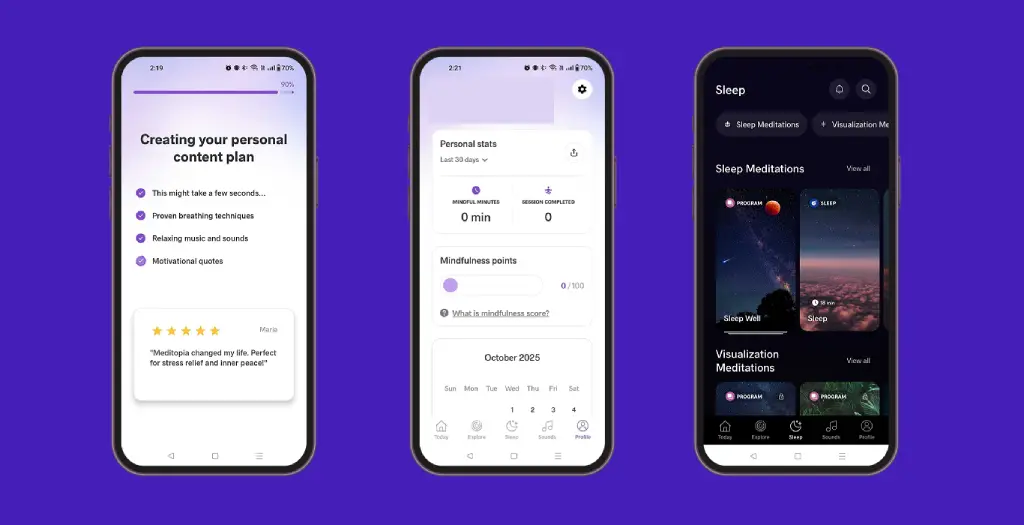Table of Contents
ToggleIn a world full of noise, peace has become rare, and that’s exactly what people now seek through their phones. Mental health mobile apps like Meditopia have turned screens into spaces of calm, helping users pause, breathe, and reconnect with themselves.
From my experience in AI mental health mobile app development, I’ve learned that building such a mobile app isn’t just about features or code; it’s about emotion. Every tap, color, and sound should feel like an exhale, not another task.
According to Statista, the global market for meditation and mental wellness apps is expected to exceed seven billion U.S. dollars by 2029. That growth reflects more than just opportunity; it’s proof that people want technology that heals, not just entertains.
This Meditopia mobile app development guide will show how to build a mental health mobile app like Meditopia that blends empathy with innovation, creating something truly meaningful in a digital world that’s always on.
Inside Meditopia: What Makes It Emotionally Intelligent?

Meditopia isn’t just another meditation mobile app; it’s a personalized mental wellness ecosystem. Its success lies in how it adapts to user emotions, habits, and cultural contexts.
The platform blends guided meditation, sleep stories, community interaction, and journaling into one smooth, user-friendly mental health mobile app. But more importantly, it feels human. Its AI algorithms understand mood trends, its design feels calming, and its multilingual approach makes wellness inclusive.
How Meditopia Creates Emotional Intelligence
| Core Focus | Design Response | Emotional Outcome |
| Personalization | AI-driven mood tracking & recommendations | Feels relevant and caring |
| Accessibility | Multilingual and local content | Feels inclusive |
| Simplicity | Minimal, calming layouts | Feels effortless to use |
Meditopia’s approach is proof that the future of emotional wellness app solutions lies in personalization and empathy-driven design.
If you’d like to see how AI is transforming mobile solutions beyond wellness, check out our article on how AI benefits mobile apps in various industries.
Step-by-Step Process to Build a Meditopia-Like Mobile App
Every great mobile app starts with an idea, but what truly defines success is how that idea turns into something people feel connected to.
From my experience working on multiple wellness and AI mental health mobile app development projects, building a Meditopia-like platform is as much about emotion as it is about execution.
Here’s how we turn that vision into a calm, meaningful, and user-friendly mental health mobile app, step by step, integrating essential mental wellness mobile app features along the way.

Step 1: Define the Purpose and the People
You don’t start with screens and features; you start with a story. Who are you building this for? Students overwhelmed by exams, professionals facing burnout, or individuals seeking daily mindfulness?
Understanding your audience defines everything: your tone, your design, and even your app’s voice.
At this stage, I usually work closely with clients to identify emotional triggers and use cases.
Key integrations at this stage:
- Mood tracking concepts: Help users log daily emotions and identify patterns.
- Journaling framework: Design early flows for reflective writing or gratitude tracking.
- Core content mapping: Plan your meditation sessions, affirmations, or group discussions so the emotional flow feels natural.
Example: Imagine a user named Maya, a 27-year-old designer dealing with stress. Your onboarding flow should instantly make Maya feel seen and supported. That empathy starts here.
Timeline: 2–3 weeks
Team involved: Product Strategist, UX Researcher, Wellness Expert
Step 2: Design the Experience Around Calmness
Design in mental health mobile apps isn’t decoration, it’s therapy. The visuals, words, and sounds must work together to create calmness. In this phase, psychology meets creativity.
Here’s where you breathe life into your idea with features that don’t just function, but feel right.
Integrate these from the start:
- Mood-based UI changes: The background softly adapts to the user’s emotion (a warm sunset for calm, gentle blues for reflection).
- Guided micro-meditations: 2–5 minute sessions for users who need a break during work or study.
- Sleep & focus tools: AI suggests soundscapes, white noise, or breathing routines at specific times.
- Community spaces: Anonymous, judgment-free areas where users can share stories or ask for help.
These aren’t just add-ons; they define your emotional architecture. A design that reflects empathy naturally builds user trust and retention.
Timeline: 3–4 weeks
Team involved: UI/UX Designers, Visual Artist, Brand Storyteller
Step 3: Choose the Right Tech Stack
Once the experience is outlined, it’s time to make sure the mobile app runs as smoothly as it feels. The technology should be fast, flexible, and, most importantly, secure.
Here’s a framework I often use for AI mental health mobile app development projects:
- Frontend: Use React Native or Flutter for fast, cross-platform development.
- Backend: Node.js and Firebase handle real-time data and smooth performance.
- Database: MongoDB or PostgreSQL stores user info, moods, and journaling data securely.
- AI/ML: Tools like TensorFlow and OpenAI API personalize content and track emotions.
- APIs: Integrate Stripe for payments and Twilio for reminders or alerts.
- Security: Apply SSL, OAuth 2.0, and JWT to keep all data safe and encrypted.
If you’re collaborating with a mobile app development company in India, you can achieve global quality at an efficient cost. Partnering with developers who understand HIPAA-compliant healthcare mobile app architecture ensures your app safeguards emotional and behavioral data responsibly.
A secure mental health application isn’t just a legal requirement; it’s a promise to your users that their healing journey is safe with you.
If you’re evaluating development partners or tech options, here’s a curated list of the top mobile app development companies in India, each offering expertise across healthcare, wellness, and AI-driven projects.
Timeline: 2–3 weeks (setup and architecture)
Team involved: Tech Lead, Backend & Frontend Developers, DevOps Engineer
Step 4: Develop and Integrate AI for Personalization
Here’s where your mobile app transforms from ordinary to extraordinary. Artificial Intelligence takes your meditation content and turns it into personalized emotional experiences.
During this stage, your mobile app starts to “understand” each user’s behavior, when they’re anxious, when they skip a session, or when they need a gentle nudge.
Features to integrate now:
- AI-based recommendations: Suggests meditation, sleep stories, or exercises based on the user’s mood.
- Smart notifications: Instead of pushing, it listens, reminding users softly when needed.
- Emotion-aware journaling: Detects tone in text and suggests reflections like “Try breathing exercises” or “End your day with gratitude.”
- Progress tracking dashboard: Visualizes user progress and emotional growth through intuitive charts.
AI doesn’t replace human empathy; it extends it. That’s the essence of powerful AI mental health mobile app development, blending machine learning with mindfulness.
Timeline: 8–10 weeks
Team involved: AI Engineers, Frontend & Backend Developers, QA Specialists
To explore more advanced wellness and tracking features, read our detailed guide on the top health monitoring mobile app features and their development cost in 2025. It highlights how similar tools are reshaping digital health experiences.

Step 5: Secure, Test, and Refine
When it comes to mental wellness mobile apps, security equals trust. Users share private thoughts, emotions, and even mental health data, and protecting it is your first responsibility.
Testing here goes beyond bug fixing. It’s about ensuring the experience feels peaceful, smooth, and private.
Checklist for this phase:
- Security validation: Ensure all data exchanges are encrypted.
- Authentication layers: Add two-step logins and session tokens.
- Compliance: Align with GDPR and HIPAA-compliant healthcare app protocols.
- Performance & emotional testing: Ensure every action, from loading a meditation to writing a journal, feels smooth and stress-free.
By refining both security and emotional usability, you build a secure mental health mobile application that users trust, even during their most vulnerable moments.
Timeline: 3–4 weeks
Team involved: QA Analysts, Security Experts, UX Testers
Step 6: Launch and Evolve Mindfully
The final step isn’t an end, it’s a new beginning. Once your mobile app is live, growth depends on how you listen and adapt.
I always remind clients that mental wellness mobile apps are living systems. They need updates, new content, and continuous improvement, all guided by user feedback.
Post-launch evolution ideas:
- Localization: Add languages and culturally relevant meditations.
- New content formats: Video lessons, expert talks, or mindfulness podcasts.
- Gamification: Gentle motivation through calm streaks or digital badges.
- AI learning: Train your algorithm to evolve based on new user trends.
A successful Meditopia mobile app development guide doesn’t stop at launch; it grows mindfully. Your users’ needs will shift with time, and your app should evolve with them.
Timeline: Continuous process
Team involved: Product Manager, Data Analyst, Marketing Team
Every step in this mindfulness mobile app development process shapes how users feel when they open your app: comforted, understood, and safe.
When you build a mental health mobile app like Meditopia, you’re not just crafting a product; you’re building a sanctuary that fits inside someone’s pocket. The code matters, yes, but the calm it delivers is what makes people come back every single day.
Now that you know how to build a mental health mobile app like Meditopia, it’s time to understand the cost side. Check out my detailed guide on how much it costs to develop a healthcare mobile app in India to explore pricing, regional variations, and key benchmarks.
Common Challenges and How to Overcome Them
Developing a mindfulness platform brings unique challenges. I’ve learned a few lessons the hard way, especially in early projects where emotional engagement was lower than expected.
Top Challenges:
- User Retention: Overcome by adding daily streaks and personalized insights.
- Sensitive Data Handling: Solved through robust encryption and privacy layers.
- Market Competition: Addressed with unique content and language localization.
The goal is to make users feel emotionally supported, not overwhelmed. Every feature in a mindfulness and meditation mobile app development process should reinforce calmness and clarity.
How AlphaKlick Helps You Build an AI-Powered Mental Health Mobile App
At AlphaKlick, I lead a team of mobile app developers, designers, and AI experts who are passionate about creating mobile apps that combine technology with emotional wellness. As a leading mobile app development company in India, we focus on building secure, scalable, and engaging mental health platforms that truly make a difference.
Here’s how we help you bring your idea to life:
- End-to-End App Development: From concept to launch, complete design, development, and deployment.
- AI-Powered Personalization: Smart recommendations and adaptive meditation experiences driven by user behavior.
- Data Security & Compliance: We follow strict HIPAA-compliant healthcare mobile app standards to protect sensitive user data.
- Scalable Architecture: Apps optimized to perform smoothly, even as your user base grows.
- Post-Launch Support: Continuous updates, new features, and marketing guidance to keep your app growing.
Whether you’re a wellness startup or an established brand, AlphaKlick helps you build a mental health mobile app like Meditopia that blends empathy with innovation.
Have an idea, question, or need clarity before you start?
You can book a consultation with me, and I’ll personally help you plan your mobile app strategy, feature roadmap, and development process with complete transparency and expert guidance.
FAQs:
Question: How to create your own health mobile app?
Answer: Start with clear goals, define your niche, and follow a structured mindfulness mobile app development process. Partnering with experienced mobile app developers ensures functionality, scalability, and emotional impact.
You can also explore our in-depth guide on how to build an AI-powered mental health mobile app: features and cost. This guide will help you create your own health mobile app.
Question: Are AI-powered mental health mobile apps safe and ethical?
Answer: Yes, if built responsibly. Follow HIPAA-compliant healthcare app standards, secure user data, and use AI only to assist users, not replace human care.
Question: What is the average timeline for a wellness mobile app project?
Answer: A basic MVP takes about 3–5 months, while full-scale mental wellness mobile app development may need 9–10 months, depending on features and integrations.
Question: Why choose a React Native mobile app development company in India for wellness apps?
Answer: Because it blends quality with cost efficiency. Indian teams skilled in React Native deliver scalable, secure, and high-performing mobile apps across Android and iOS.

